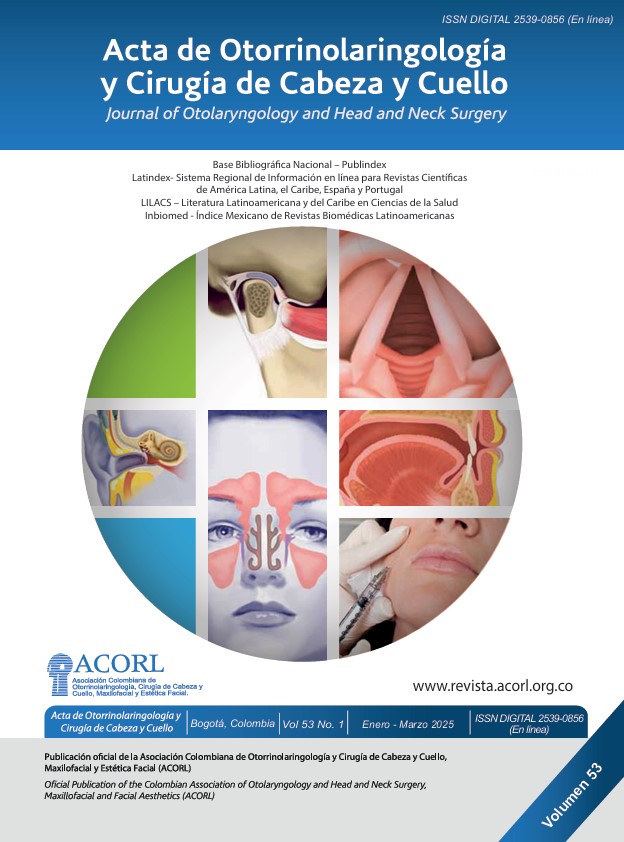Sociodemographic profi le and quality of life evaluation in patients with cleft nasal deformities: Insights from a colombian coast reference center
Main Article Content
Abstract
Introduction: Cleft nose, associated with cleft lip with or without cleft palate, is the most common craniofacial congenital defect, occurring in 1:500 to 1:2000 individuals worldwide. This condition may have significant functional and psychosocial implications, yet it is often underestimated in most patients. Methods: An analytical longitudinal prospective observational study was designed to characterize the sociodemographic profile and assess the quality of life in 17 patients with cleft nose who the Otorhinolaryngology Department of the University Hospital of the Caribbean followed. Patient-reported scales NOSE, SCHNOS, and CLEFT-Q were utilized to evaluate nasal obstruction, nasal function, and health-related quality of life. Results: Most patients perceive an acceptable quality of life regarding nasal obstruction and respiratory function, although significant concerns regarding nasal aesthetics were observed. Patients reported a variety of psychological, social, and functional difficulties associated with their condition. Conclusion: This study underscores the complexity of cleft nose and its impact on patients’ quality of life. It provides a solid foundation for comprehensive preoperative assessment and highlights the need for multidisciplinary approaches to addressing these patients’ medical and psychosocial concerns.
Downloads
Article Details

This work is licensed under a Creative Commons Attribution-ShareAlike 4.0 International License.
Este artículo es publicado por la Revista Acta de Otorrinolaringología & Cirugía de Cabeza y Cuello.
Este es un artículo de acceso abierto, distribuido bajo los términos de la LicenciaCreativeCommons Atribución-CompartirIgual 4.0 Internacional.( http://creativecommons.org/licenses/by-sa/4.0/), que permite el uso no comercial, distribución y reproducción en cualquier medio, siempre que la obra original sea debidamente citada.
eISSN: 2539-0856
ISSN: 0120-8411
References
Noor SN, Musa S. Assessment of patients’ level of satisfaction with cleft treatment using the Cleft Evaluation Profile. Cleft Palate Craniofac J. 2007;44(3):292-303. doi: 10.1597/05-151
Rando GM, Jorge PK, Vitor LLR, Carrara CFC, Soares S, Silva TC, et al. Oral health-related quality of life of children with oral clefts and their families. J Appl Oral Sci. 2018 Feb 1;26:e20170106. doi: 10.1590/1678-7757-2017-0106
Tsangaris E, Riff KWYW, Vargas F, Aguilera MP, Alarcón MM, Cazalla AA, et al. Translation and cultural adaptation of the CLEFT-Q for use in Colombia, Chile, and Spain. Health Qual Life Outcomes. 2017;15(1):228. doi: 10.1186/s12955 017-0805-7
Sykes JM, Tasman AJ, Suárez GA. Cleft Lip Nose. Clin Plast Surg. 2016;43(1):223-35. doi: 10.1016/j.cps.2015.09.016
Baskaran M, Packiaraj I, Arularasan SG, Divakar TK. Cleft rhinoplasty. J Pharm Bioallied Sci. 2015;7(Suppl 2):S691-4. doi: 10.4103/0975-7406.163480
Vass G, Mohos G, Bere Z, Ivan L, Varga J, Piffko J, et al. Secondary correction of nasal deformities in cleft lip and palate patients: surgical technique and outcome evaluation. Head Face Med. 2016;12(1):34. doi: 10.1186/s13005-016-0132-y
Gassling V, Koos B, Birkenfeld F, Wiltfang J, Zimmermann CE. Secondary cleft nose rhinoplasty: Subjective and objective outcome evaluation. J Craniomaxillofac Surg. 2015;43(9):1855 62. doi: 10.1016/j.jcms.2015.08.012
Oommen J, Koyappathody HM, Kalathingal K, Thamunni CV, Joseph S, Shet SM, et al. Three Dimensional Rhinoplasty and Nasal Airway Improvement in Cleft-Nose Deformity. Indian J Otolaryngol Head Neck Surg. 2019;71(4):512-16. doi: 10.1007/ s12070-019-01690-2
Shukla RH, Nemade SV, Shinde KJ. Comparison of visual analogue scale (VAS) and the Nasal Obstruction Symptom Evaluation (NOSE) score in evaluation of post septoplasty patients. World J Otorhinolaryngol Head Neck Surg. 2020;6(1):53-58. doi: 10.1016/j.wjorl.2019.06.002
Singh A, Patel N, Kenyon G, Donaldson G. Is there objective evidence that septal surgery improves nasal airflow? J Laryngol Otol. 2006;120(11):916-20. doi: 10.1017/S0022215106003410
Reeve BB, Wyrwich KW, Wu AW, Velikova G, Terwee CB, Snyder CF, et al. ISOQOL recommends minimum standards for patient-reported outcome measures used in patient-centered outcomes and comparative effectiveness research. Qual Life Res. 2013;22(8):1889-905. doi: 10.1007/s11136-012-0344-y
Moubayed SP, Ioannidis JPA, Saltychev M, Most SP. The 10-Item Standardized Cosmesis and Health Nasal Outcomes Survey (SCHNOS) for Functional and Cosmetic Rhinoplasty. JAMA Facial Plast Surg. 2018;20(1):37-42. doi: 10.1001/ jamafacial.2017.1083
Lee MK, Most SP. A Comprehensive Quality-of-Life Instrument for Aesthetic and Functional Rhinoplasty: The RHINO Scale. Plast Reconstr Surg Glob Open. 2016;4(2):e611. doi: 10.1097/ GOX.0000000000000592
Din H, Bundogji N, Leuin SC. Psychometric Evaluation of the Nasal Obstruction Symptom Evaluation Scale for Pediatric Patients. Otolaryngol Head Neck Surg. 2020;162(2):248-54. doi: 10.1177/0194599819890835
Portillo-Vásquez AM, Jiménez-Chobillón MA, Santillán Macías A, Cristerna-Sánchez L, Castorena-Maldonado AR. Validation of the Nasal Obstruction Symptom Evaluation Scale in Mexican Adults. Arch Med Res. 2022;53(3):329-35. doi: 10.1016/j.arcmed.2022.02.002
Stewart MG, Witsell DL, Smith TL, Weaver EM, Yueh B, Hannley MT. Development and validation of the Nasal Obstruction Symptom Evaluation (NOSE) scale. Otolaryngol Head Neck Surg. 2004;130(2):157-63. doi: 10.1016/j. otohns.2003.09.016
van Schijndel O, Litschel R, Maal TJ, Bergé SJ, Tasman AJ. Eye tracker based study: Perception of faces with a cleft lip and nose deformity. J Craniomaxillofac Surg. 2015;43(8):1620-5. doi: 10.1016/j.jcms.2015.07.003
Bueller H. Ideal Facial Relationships and Goals. Facial Plast Surg. 2018;34(5):458-65. doi: 10.1055/s-0038-1669401
Dixon MJ, Marazita ML, Beaty TH, Murray JC. Cleft lip and palate: Understanding genetic and environmental influences. Nat Rev Genet. 2011;12(3):167-78. doi: 10.1038/nrg2933
Mondragón S, Carrascal M, Hernández D, Sarmiento O, Fernández K, Noriega M. Caracterización de Usuarios Con Fisura Labiopalatina Atendidos Por Operación Sonrisa En Cartagena. Revista Areté. 2014;14(1):120-26.
Rhee JS, Daramola OO. No need to fear evidence-based medicine. Arch Facial Plast Surg. 2012;14(2):89-92. doi: 10.1001/archfacial.2011.1182
Perez-Garcia IC, Peñaranda A, Cobo R, Hernandez AV, Moubayed SP, Most SP. Spanish Translation, Cultural Adaptation, and Validation of the Standardized Cosmesis and Health Nasal Outcomes Survey Questionnaire. Plast Reconstr Surg Glob Open. 2019;7(3):e2153. doi: 10.1097/ GOX.0000000000002153
Meyer-Marcotty P, Gerdes ABM, Reuther T, Stellzig Eisenhauer A, Alpers GW. Persons with cleft lip and palate are looked at differently. J Dent Res. 2010;89(4):400-4. doi: 10.1177/0022034509359488
Berger ZE, Dalton LJ. Coping with a cleft: psychosocial adjustment of adolescents with a cleft lip and palate and their parents. Cleft Palate Craniofac J. 2009;46(4):435-43. doi: 10.1597/08-093.1
Wong Riff KWY, Tsangaris E, Forrest CR, Goodacre T, Longmire NM, Allen G, et al. CLEFT-Q: Detecting Differences in Outcomes among 2434 Patients with Varying Cleft Types. Plast Reconstr Surg. 2019;144(1):78e-88e. doi: 10.1097/ PRS.0000000000005723

